Buttery, soft and full of fluffy layers, is there anything better than homemade biscuits? Made with all butter, no shortening and no buttermilk, you’ll be amazed how easy they are to make.
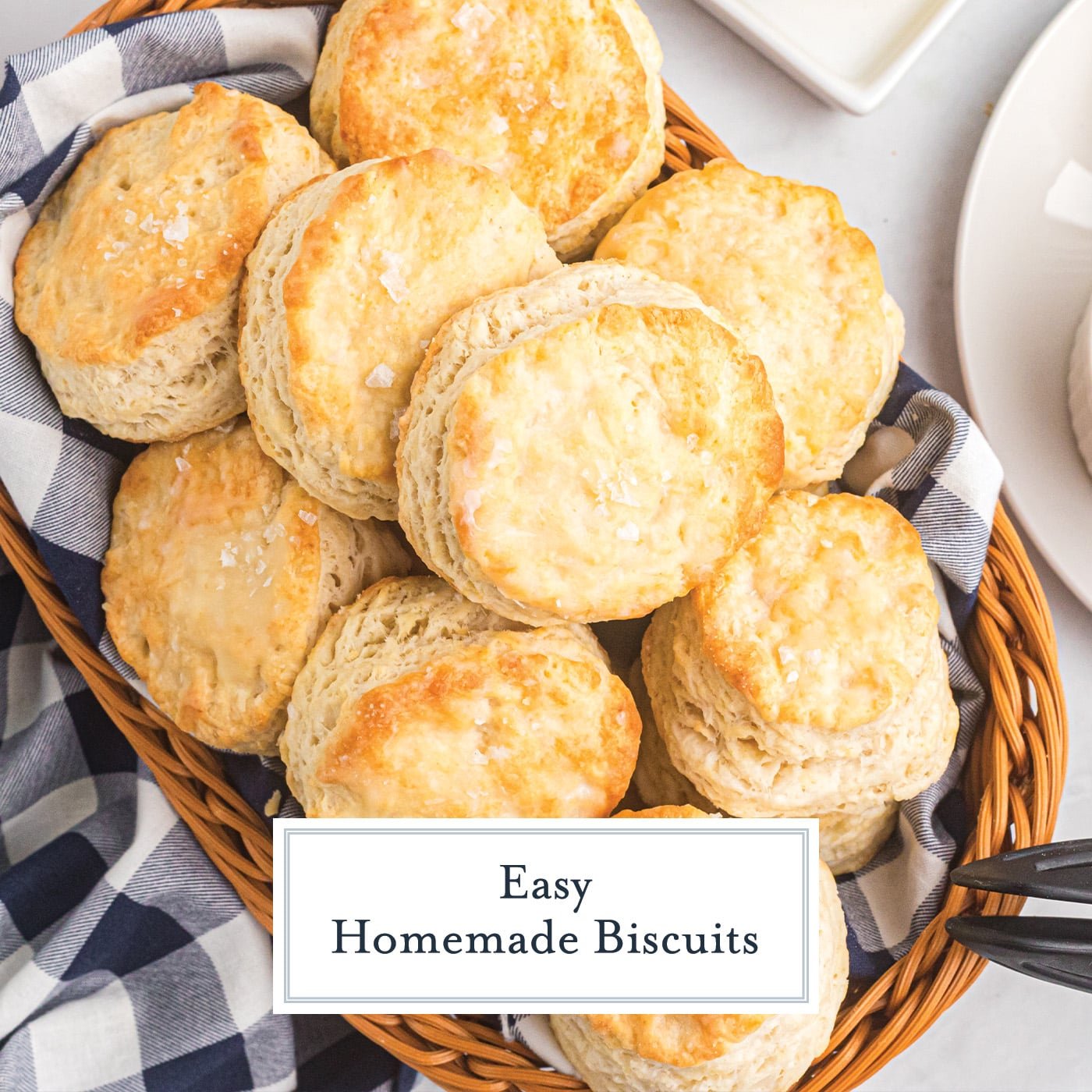
In many parts of the US, how you make biscuits, how you serve biscuits and where your coveted biscuit recipe came from are badges of honor… or fighting words. Many families take their biscuit making seriously.
For me, they are kind of like Italian tomato sauce or pizza, there are so many good kinds, but rarely one is ever THE BEST. And how can you compare with so many types of biscuits out there? Yeast biscuits, sourdough biscuits, drop biscuits, cheese biscuits, buttermilk biscuits and the list goes on…
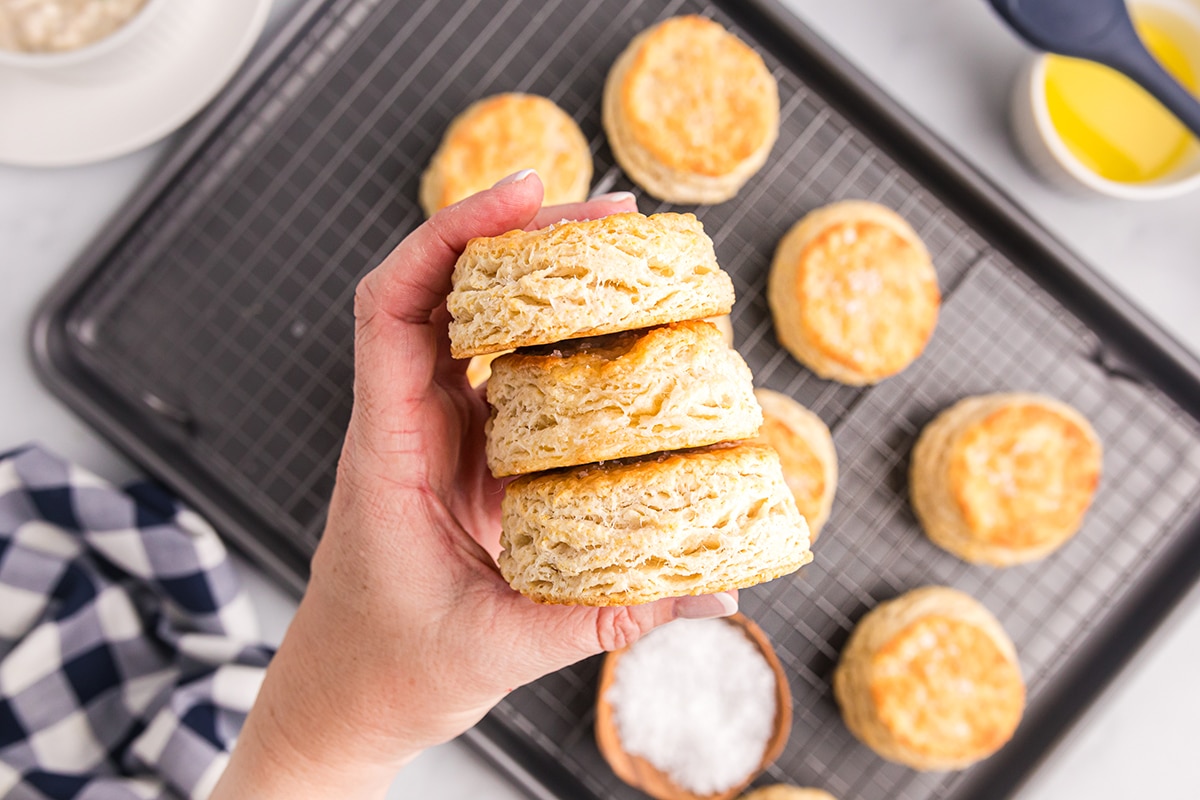
Why You’ll Love These Homemade Biscuits
Our biscuits are a little different, but oh so good and will not disappoint. This biscuit recipe is simple and doesn’t require a sourdough starter, yeast or rising time OR buttermilk. You heard right, no buttermilk in these biscuits.
- Pantry Staples– For me, buttermilk, yeast and sourdough starter is NOT on my usual pantry staple list, and I would venture to guess not for many others either. These fluffy biscuits come together with none of these and get their unique texture from cream of tartar, much like snickerdoodle cookies.
- Chef Created– While 95% of the recipes here are created by me, this one was developed and tested by a very skilled chef for our use only, making it quite literally a restaurant quality biscuit.
- Easy– We all know I am a lazy baker, these are easy and quick. I promise.
- Buttery & Salty– I do love my salt and these are basting with more butter and sprinkled with a light flaky sea salt, adding texture and flavor to each fluffy biscuit.
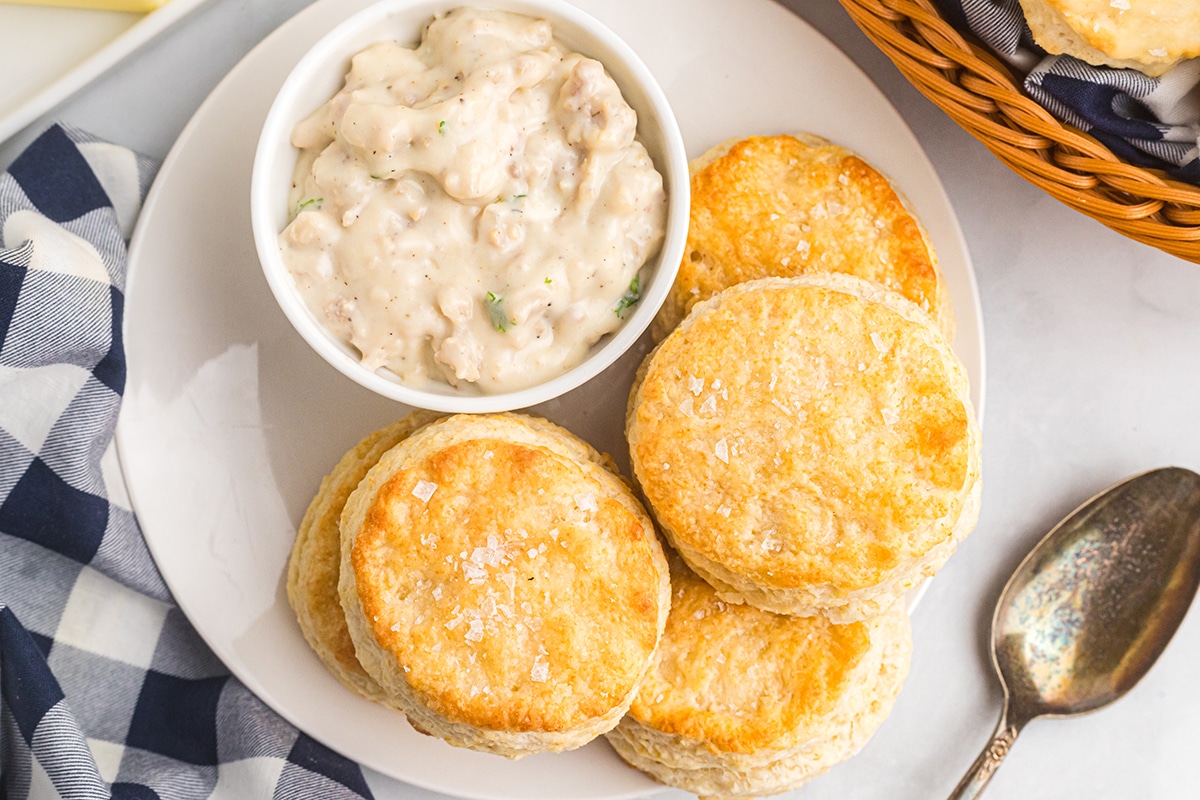
Biscuits without Buttermilk
Some folks don’t even know there is such a thing! Buttermilk is used in biscuits because its acidity helps activate baking soda, which in turn leavens the dough and creates a light and fluffy texture. Additionally, buttermilk adds a tangy flavor and richness to the biscuits, enhancing their overall taste and tenderness.
But delicious homemade biscuits can be achieved without buttermilk by using cream of tartar. Cream of tartar is often used in biscuits as an acid to activate baking soda, helping the dough rise and become lighter and fluffier. It also stabilizes the whipped egg whites, if used, to provide structure and maintain the biscuit’s desired texture.
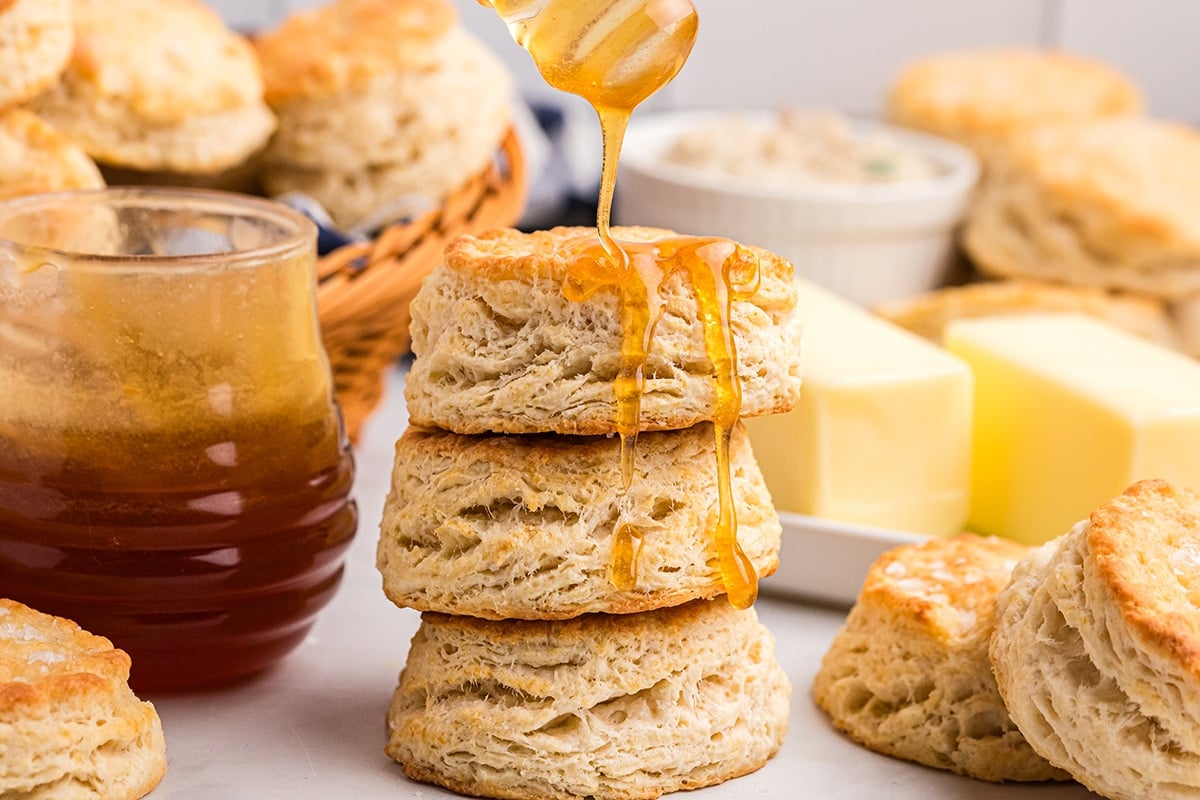
What Ingredients Do I Need for Homemade Biscuits?
It’s been mentioned before, but I’ll say it again. Easy, simple ingredients you likely already have on hand, are all you need for the best biscuit recipe!
- Unsalted Butter– You’ll need this three times, for the biscuit dough, for basting them when they come out and more butter for buttering them up!
- All-Purpose Flour– For structure and lift.
- Sugar– Just plain white sugar will work. It helps to heighten flavors, but also gives caramelizes giving the tops of your biscuits a golden brown hue.
- Fine Sea Salt– Salt brings out natural flavors in the other ingredients. I do prefer a fine sea salt in this recipe- less after taste, but dissolves and distributes quickly.
- Baking powder– Baking powder is a leavening agent used in baking to help baked goods rise and become light and fluffy. It achieves this by producing carbon dioxide gas when mixed with moisture and an acidic ingredient, causing the dough or batter to expand and create a soft, airy texture in the final product.
- Cream of Tartar– Cream of tartar, chemically known as potassium hydrogen tartrate, is used primarily in baking to stabilize and increase the volume of whipped egg whites. It also activates baking soda in recipes, acting as a leavening agent in the absence of acidic ingredients like buttermilk or yogurt.
- Egg– For structure and binding.
- Whole Milk– The liquid to make these so soft is regular milk. Biscuits are not the time to go all healthy, so I ask that you use whole milk. Skim milk and 2% will work, but won’t be as rich. This recipe has not been tested with soy or nut milks, but there is no reason why it wouldn’t work.
- Flakey Sea Salt– Little flakes and pyramid salt crystals will be what take your biscuits from regular to over-the-top. My favorite brands are Maldon and Jacobson.
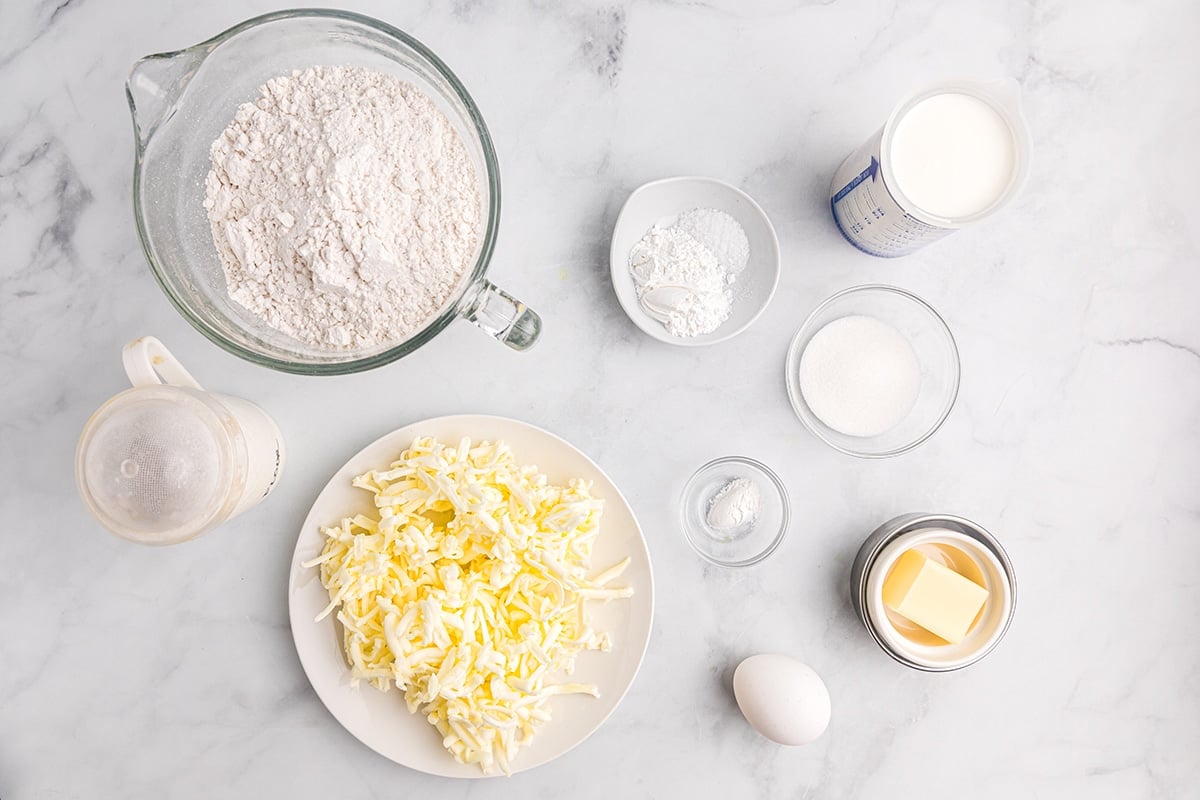
How to Make Homemade Biscuits
Make this easy homemade biscuits recipe in a snap! Just read through the instructions once first and keep your basic ingredients cold.
- Freeze Butter. Place the grated butter in the freezer for a minimum of 10 minutes while you prepare the rest of the ingredients. You can go up to 20 minutes, but no longer or it will be frozen solid.
- Prep. Preheat the oven and line a large baking sheet with parchment paper. If you want doughier, tall biscuits, place them close together in a 9×13 baking pan. If you don’t have parchment paper, lightly grease with vegetable shortening. Do not use butter, it will burn.
- Sift. In a large mixing bowl, sift or whisk together the flour, sugar, salt, baking powder and cream of tartar so that all of the dry ingredients are well incorporated.
- Cut Dough. Remove the cold grated butter from the freezer (after 10 minutes of chilling) and cut it into the same large bowl as the dry ingredients using two forks or a pastry cutter/pastry blender. There will still be small pieces of butter in the dough, like coarse crumbs. Some folks prefer to use a food processor and give it a few quick pulses.
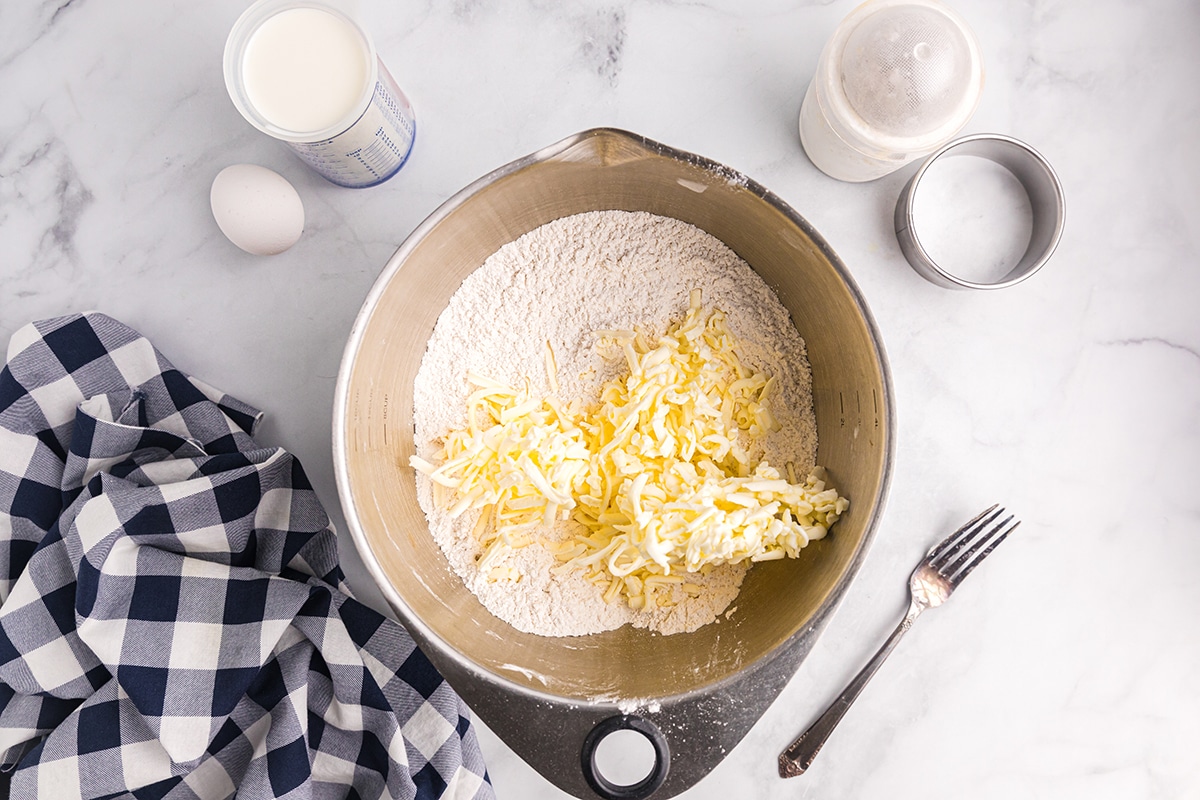
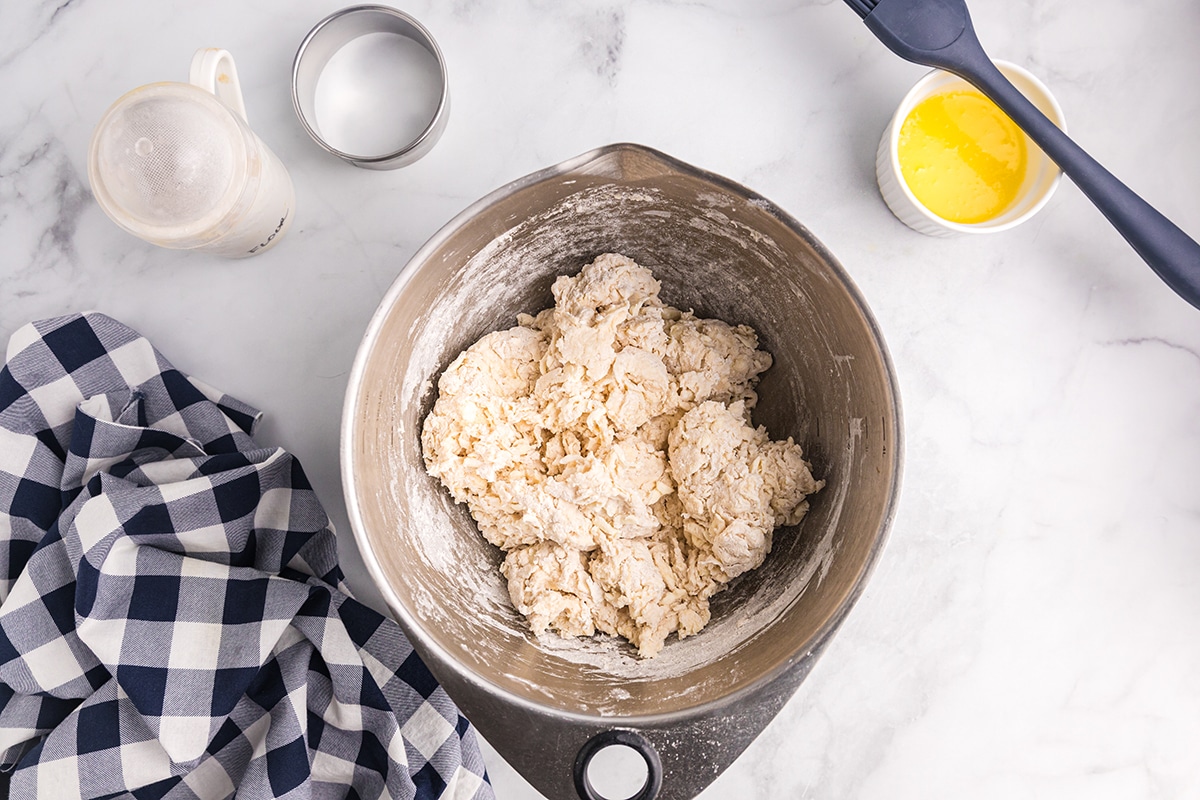
- Wet Ingredients. Add the egg and milk to the dry ingredients and mix until just combined. The dough will be a bit sticky at this point. When the dough starts to pull any remaining flour into itself and pull slightly away from the sides of the bowl, it’s ready to form and knead.
- Laminate/Knead. On a lightly floured surface, knead (laminating) the dough by forming into a ball, turning it ¼ turn, then folding the top half of it onto itself on the bottom, and pressing the entire dough with the palm of your hand. Don’t add too much flour, this will dry out the dough. Repeat this process about 4 to 5 more times, until your dough is combined and smooth. Do not over knead this dough; the butter should still feel cold/cool once it comes together. The heat of your hands will start to warm up the butter which will affect how the biscuits bake.
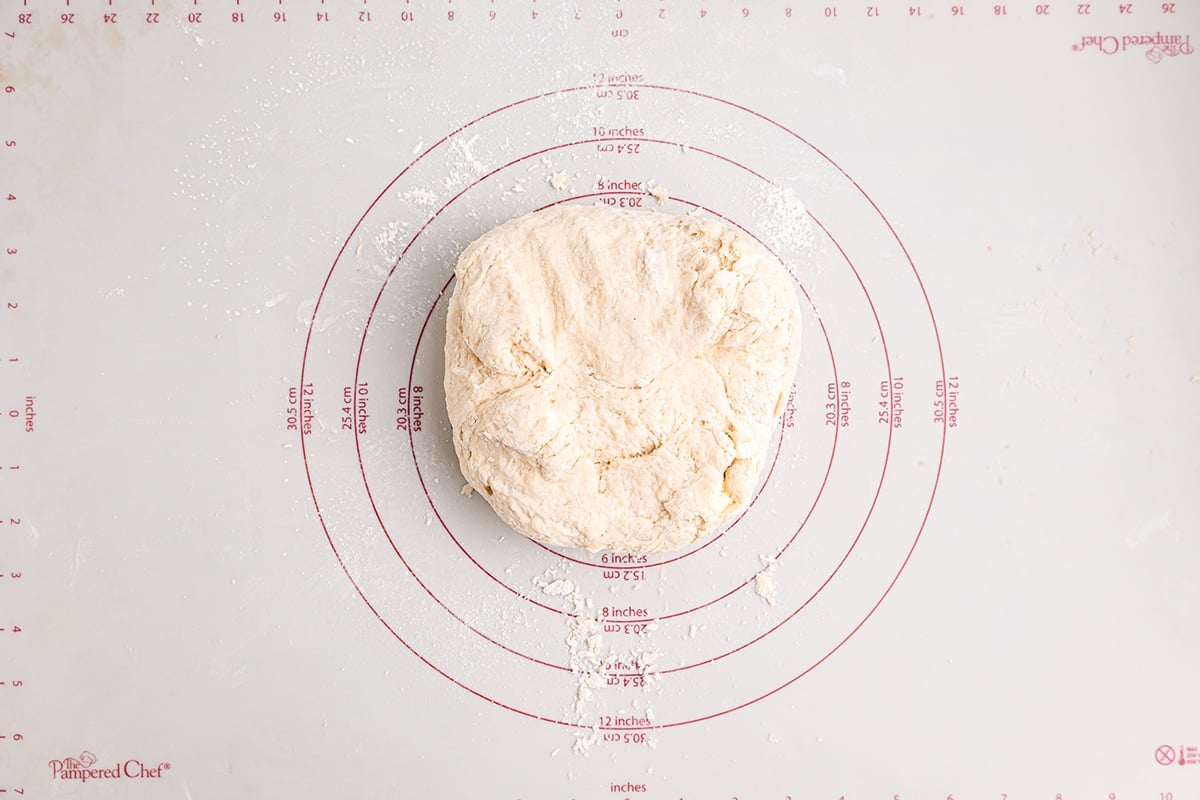
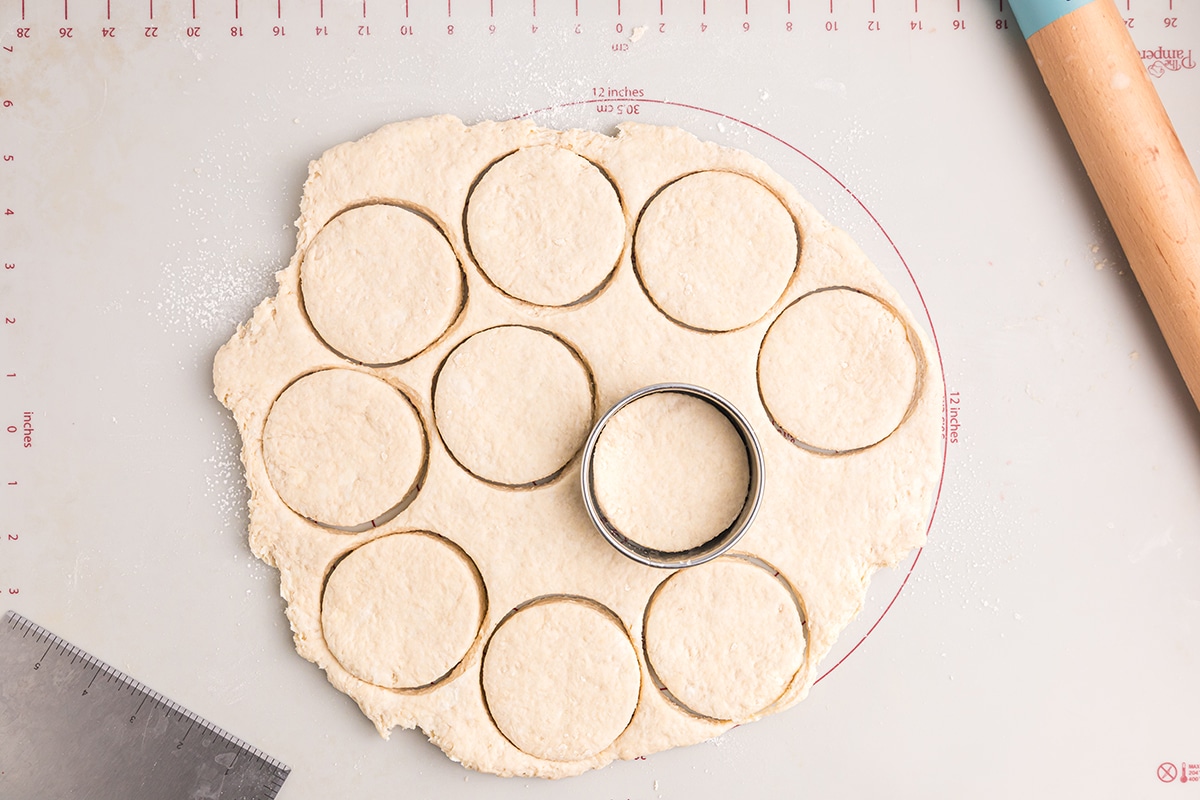
- Cut. Using a floured rolling pin, press the dough flat to about ¾” to ½“ thick then cut with a 3” round cookie or biscuit cutter. Press it straight down, turn quickly to cut the dough and move on. Cut as many biscuits as you can then quickly rework the dough to get more biscuits. You should get at least 1 dozen pieces. Reform and roll the dough to get more.
- Bake. Place unbaked biscuits on a parchment lined baking sheet. Bake for 10 – 12 minutes until just golden brown. You can also place them tightly in a 9×13 pan or cast iron skillet and they will be more doughy and rise super high.
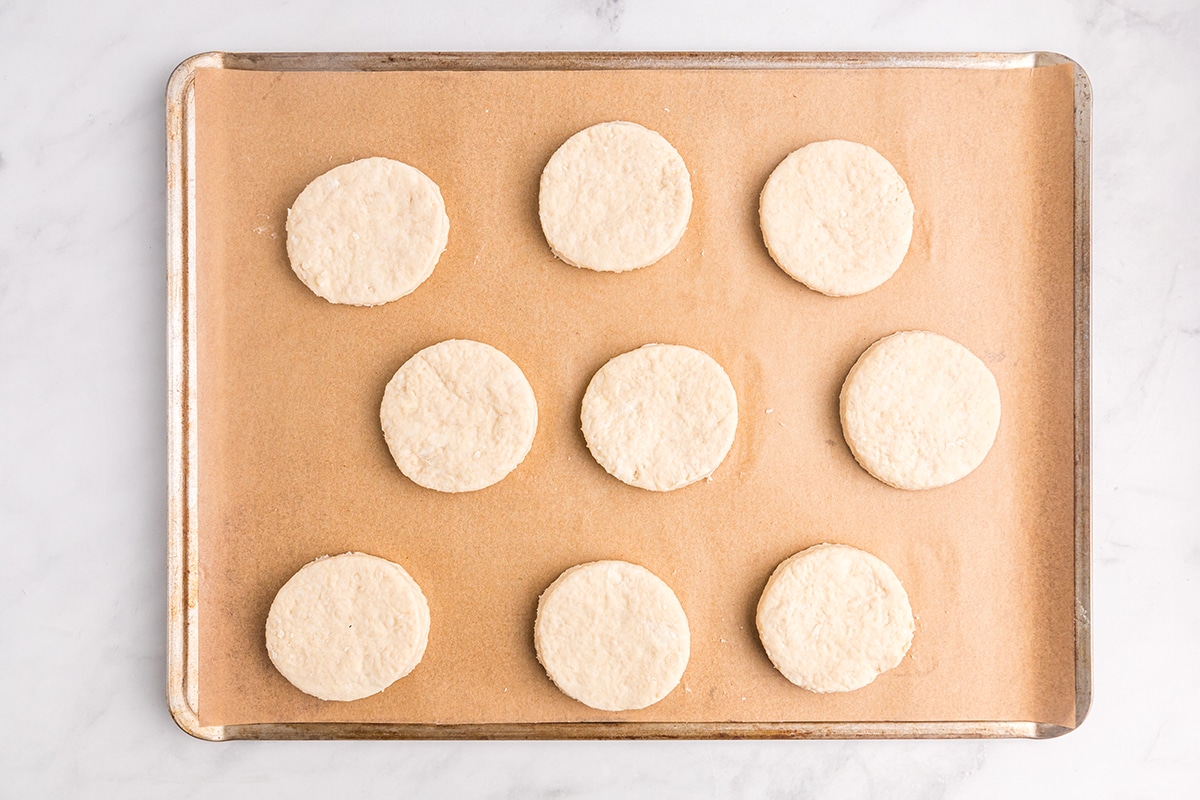
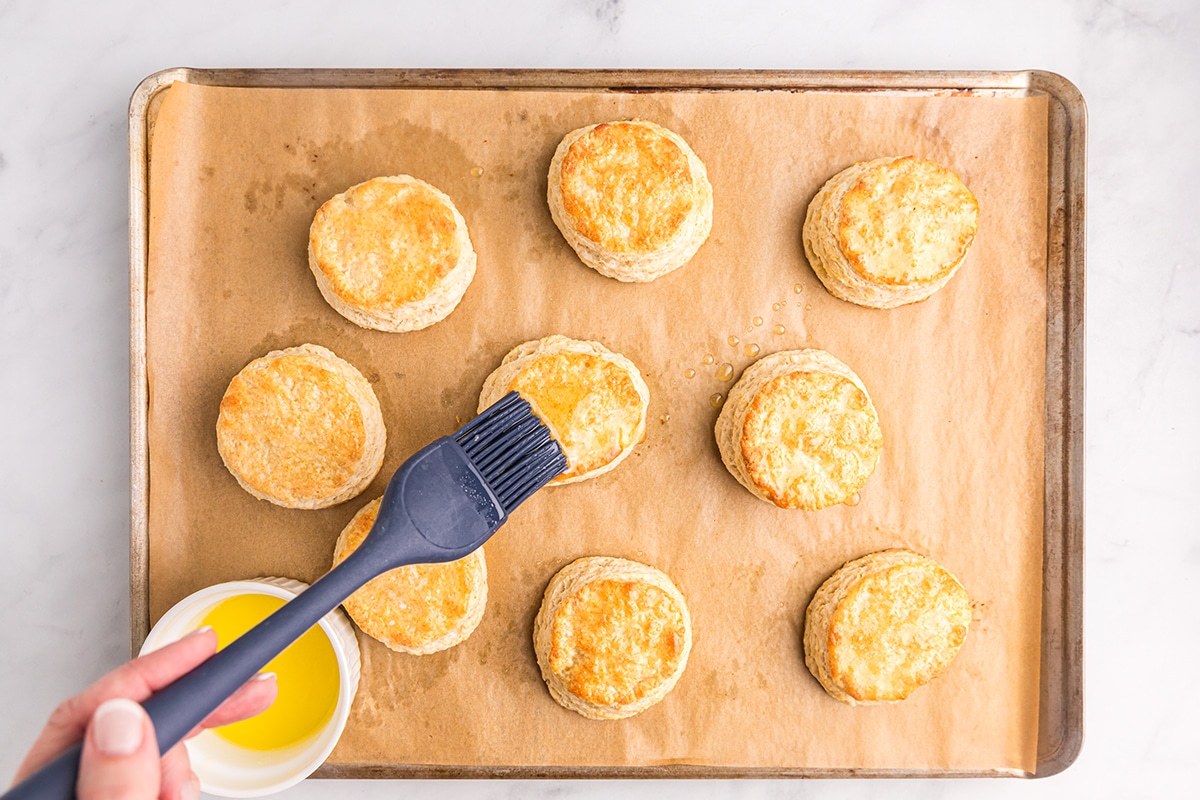
- Baste and Top. Brush with the melted butter for topping, and sprinkle with flakey seas salt if desired, and serve warm or at room temperature. Can also be served with your favorite jams and jellies, or a delicious and creamy sausage gravy.
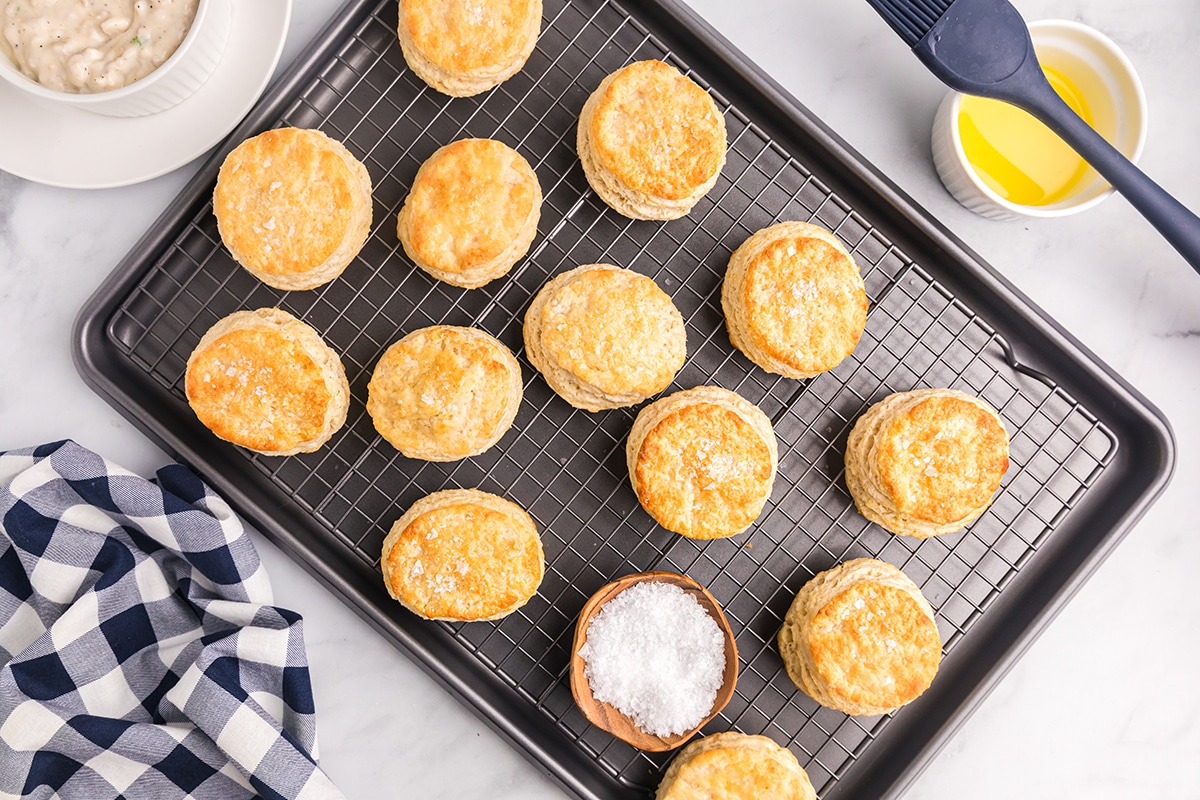
Are Biscuit Cutters and Cookie Cutters The Same?
A biscuit cutter is typically different from a cookie cutter. Biscuit cutters are designed with sharp edges and straight sides to cut through biscuit dough, creating clean and even edges. They also typically have a handle to make it easy to cut, twist and move on.
Cookie cutters, on the other hand, typically don’t have edges as sharp as biscuits cutters and come in many designs. You can use these fun designs for biscuits too, but keep in mind they will rise so anything too intricate will likely look blobby.
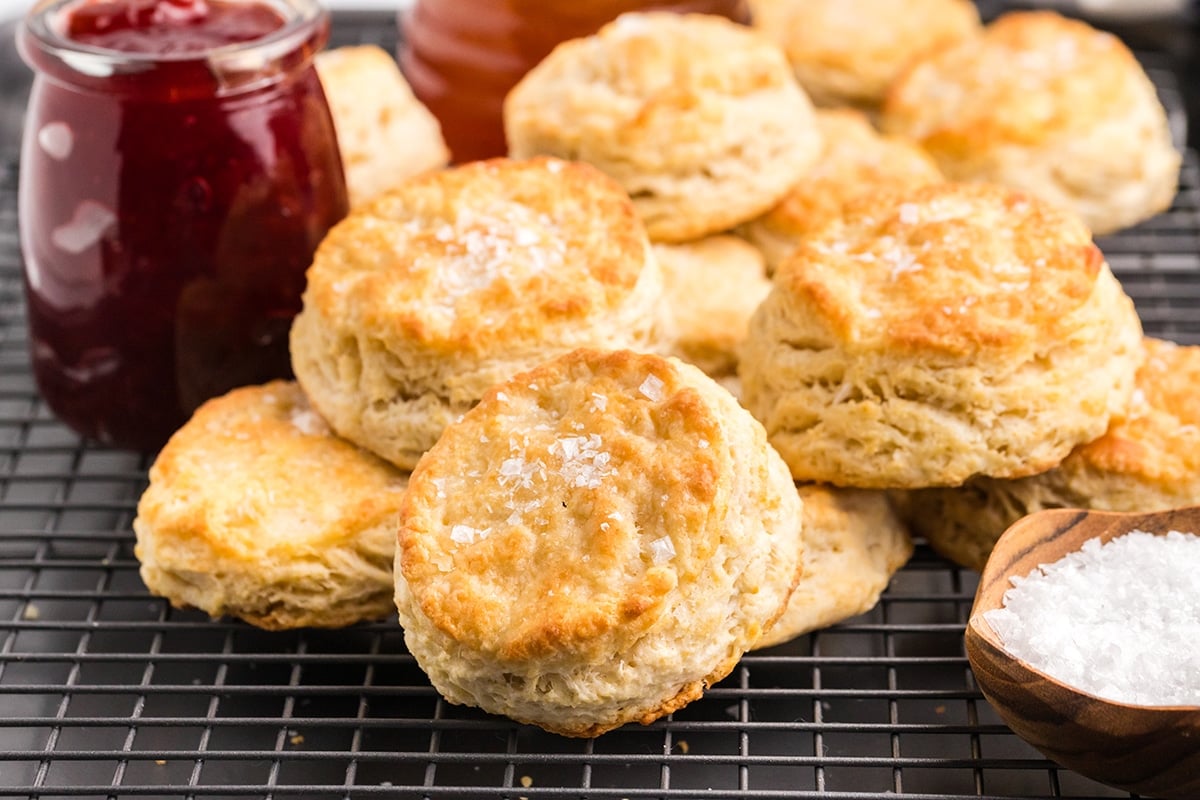
Ways to Serve Biscuits
Homemade biscuits can be served in various delicious ways, but those are generally broken down into savory and sweet. Think of them as a blank canvas waiting to be painted!
- Savory: For a classic southern-style biscuits, serve them with creamy sausage gravy. This iconic dish, known as “Biscuits and Gravy,” is a hearty and comforting breakfast or brunch option. You can also use them as the bottom for eggs benedict or on a breakfast sandwich or even breakfast burger! Go for a blend of savory and sweet with Hot Honey (spicy honey).
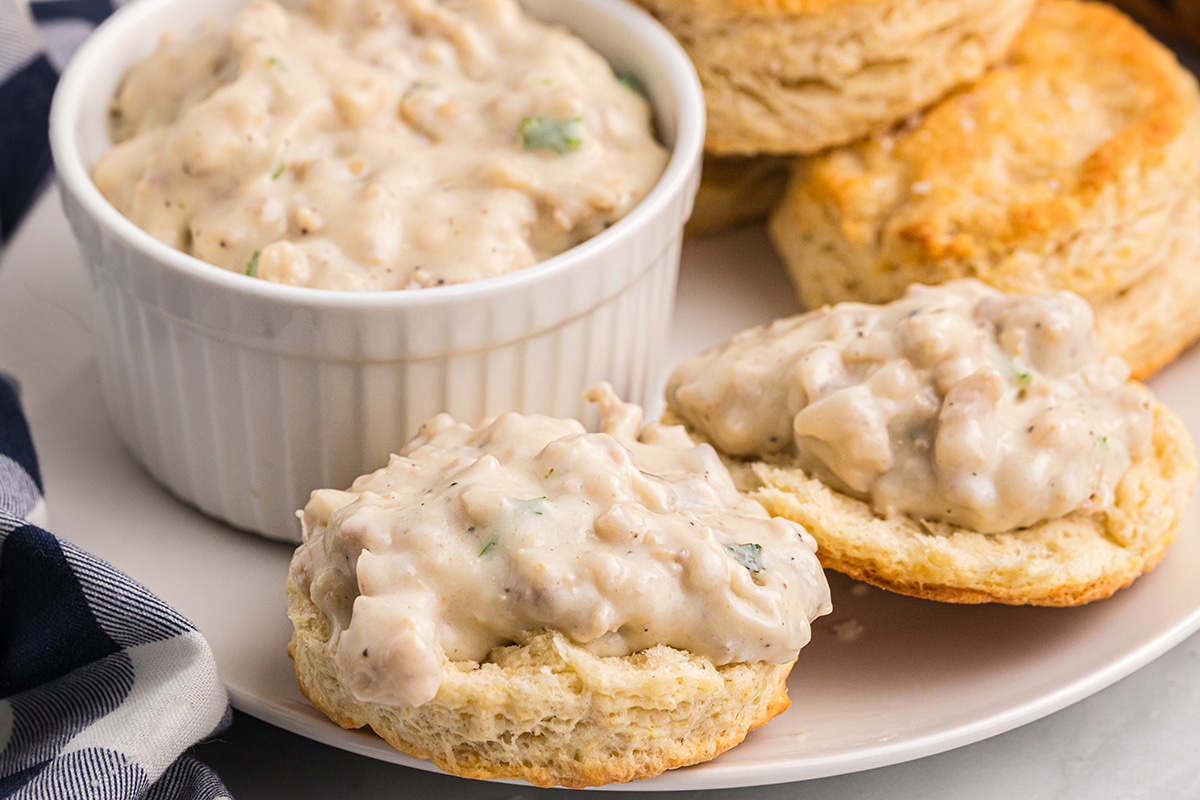
- Sweet Treat: Biscuits can also be turned into a sweet treat. After baking, allow them to cool slightly, then split them open and fill them with whipped cream, vanilla custard and fresh berries for a delightful strawberry shortcake. Alternatively, you can serve biscuits with butter and honey or jam. Cherry jam, bacon jam, vanilla syrup, honey butter and cranberry syrup are my favorites. Also top with a scoop of vanilla ice cream.
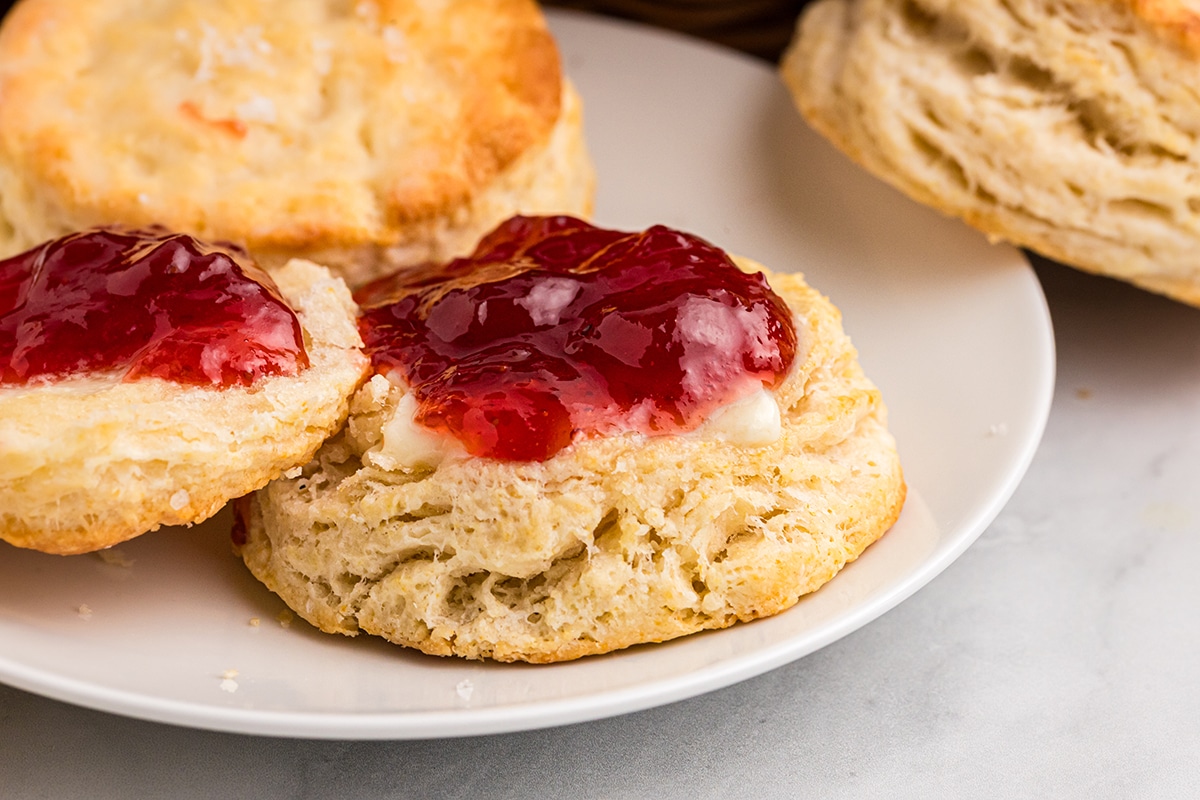
Whether you go for a savory or sweet approach, homemade biscuits are best served warm, right out of the oven, to enjoy their flaky, buttery goodness to the fullest.
What’s the Trick to Making Biscuits?
While making biscuits is easy, there are, of course, a few tips to ensure you get the best results for this easy biscuit recipe.
- Chill, but don’t freeze the butter– This recipe was tested with grated butter in the freezer for 10 minutes, yet it could go up to 20 minutes if needed. Don’t go longer or it will be pretty solid and not blend in at all.
- Twist the cookie cutter- Twisting a biscuit cutter when cutting biscuit dough helps to create a clean and sharp edge on the biscuit. It seals the edges of the dough together slightly, which can encourage the biscuits to rise evenly and higher during baking. The twisting motion helps prevent the biscuits from being compressed and allows them to expand upward, resulting in a fluffier and more tender texture.
- Don’t Overmix & Handle Dough Gently– Mix the dough just until it comes together to avoid tough biscuits. Pat or roll the dough gently to maintain a tender texture. This can over activate the gluten, making it dry or chewy.
- High Rise– If you want higher, doughier biscuits, place them in pan close together so they are forced to expand up and not out.
- Cold Ingredients– Not only do I ask you to keep the butter cold, also keep the milk and eggs that way too so they don’t increase the temp of the dough while making.
- Layers– Those fluffy layers are in part made by pockets of steam from butter, but also by a process called laminating the dough. Laminating just means to fold the dough over on top of itself, in this case just a few times, to make layers.
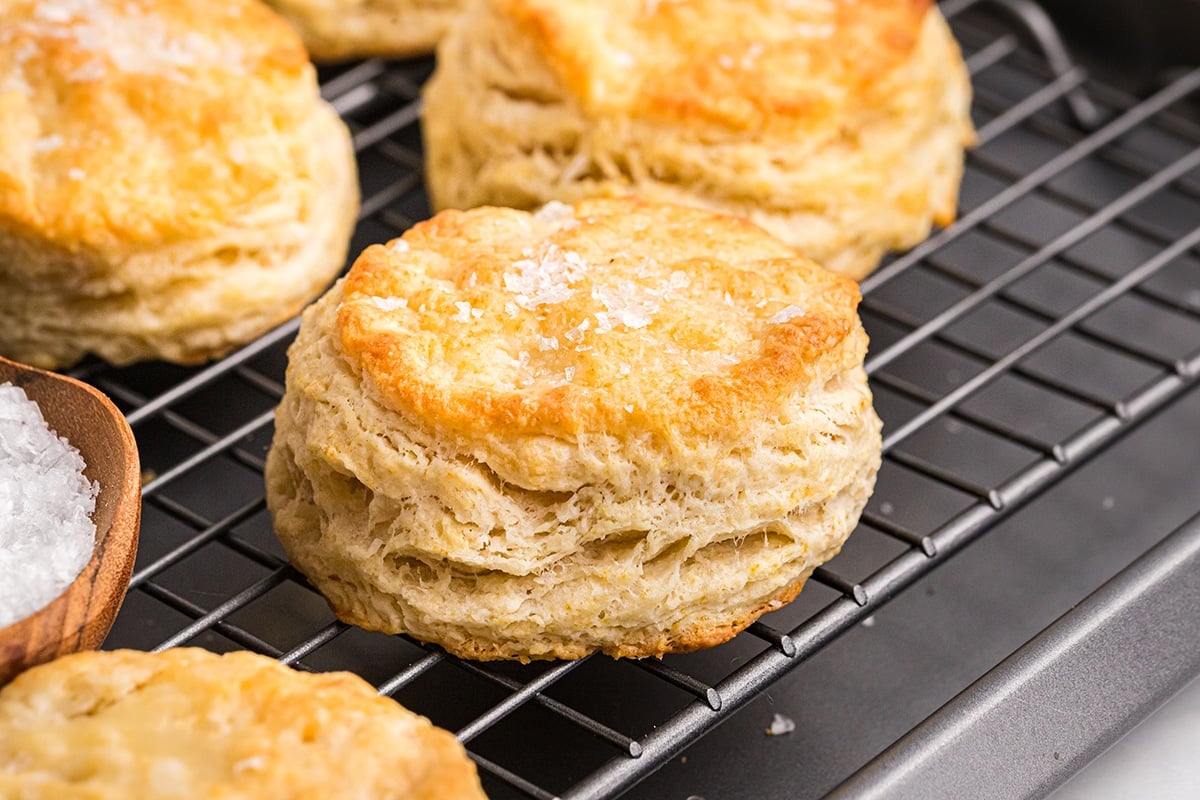
Make-Ahead, Storage & Freezing
How to Store Leftover Biscuits
Whether they are leftovers or you made them ahead, baked biscuits can be left at room temperature in an airtight container for up to 2 days after baking, or in the refrigerator in an airtight container for up to 3 days after baking.
How to Freeze Biscuits
Freeze cooked biscuits in an airtight plastic bag, removing as much air as possible. Freeze for up to 6 months. Thaw at room temperature for about 30 minutes. I hghly suggest reheating them before consuming.
How to Reheat Biscuits
To reheat, place your biscuit(s) into the toaster oven and toast on a low setting for about 1-2 minutes, depending on desired degree of doneness. You can reheat these in a microwave at 50% power for 30 seconds to 1 minute.
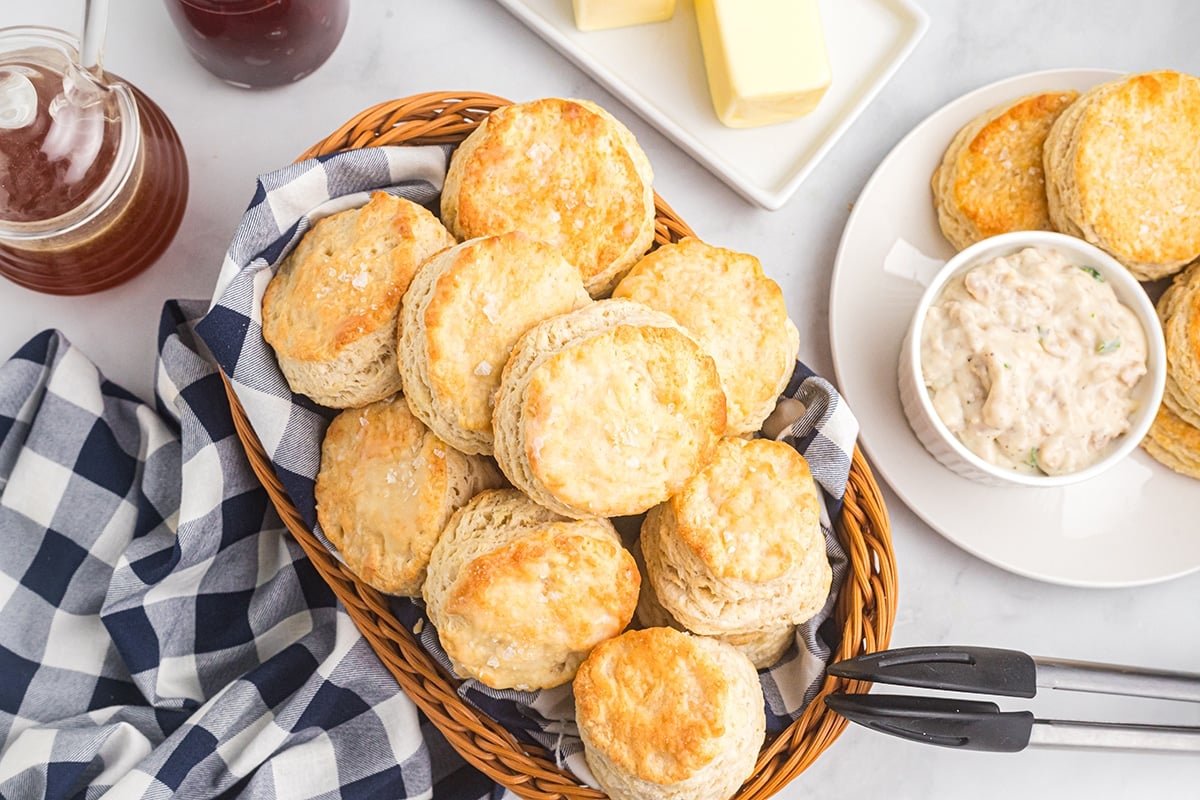
Biscuits Commonly Asked Questions
It seals the edges of the dough together slightly, which can encourage the biscuits to rise evenly and higher during baking. The twisting motion helps prevent the biscuits from being compressed and allows them to expand upward, resulting in a fluffier and more tender texture.
In order to show multiple flaky layers, you want the butter to stay as cold as possible when molding and pressing out the biscuits. With cold butter, as it bakes it creates steam and this process adds to their texture.
A 2 1/2 inch biscuit cutter will yield approximately 20-24 biscuits; a larger cutter around 4 inches will yield only about 10-12 biscuits.
You certainly can if you crave that tang and have it on hand. Because buttermilk is thicker, you’ll likely only need 3/4 of a cup, but you’ll be working based on the texture of the dough. Cream can also used in a lesser amount.
Not for this recipe. The ratios of baking powder and salt aren’t the same as in a typical self-rising flour.
More Biscuit Recipes
Butter Swim Biscuits
Everything Seasoning Biscuits
French Onion Chicken Casserole Recipe
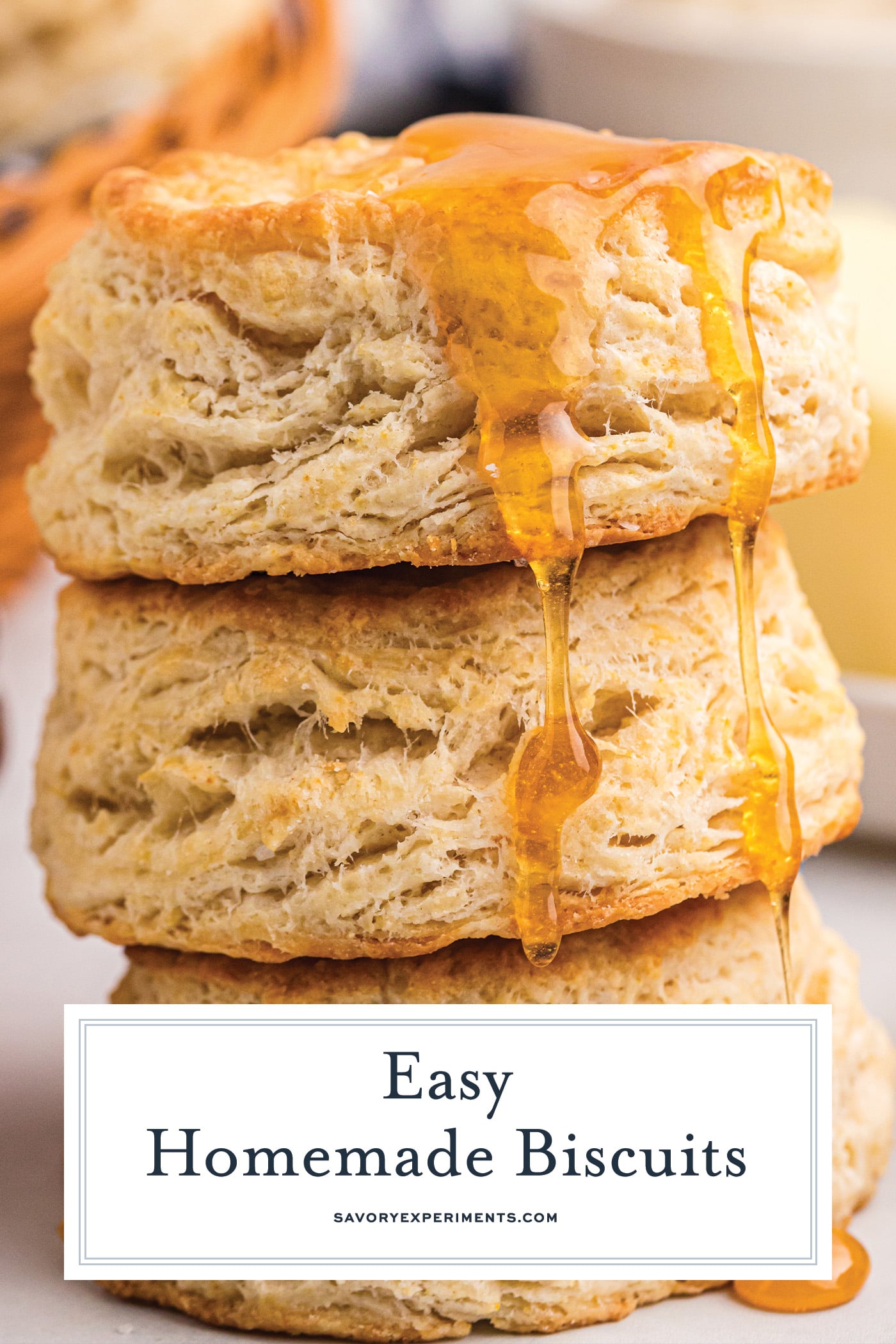
Biscuits from Scratch (Biscuits without Buttermilk)
Equipment
Ingredients
Biscuits:
- ¾ cup unsalted butter , cold & grated
- 3 cups all-purpose flour , plus more of kneading
- 2 tablespoon granulated sugar
- ½ teaspoon fine sea salt
- 4 teaspoons baking powder
- ½ teaspoon cream of tartar
- 1 egg
- 1 cup whole milk
Topping:
- 2 tablespoons unsalted butter , melted
- Maldon Sea Salt Flakes , optional
Instructions
- Place the grated butter in the freezer for a minimum of 10 minutes while you prepare the rest of the ingredients.
- Preheat the oven to 425F. Line a large baking sheet with parchment paper. Set aside.
- In a large mixing bowl, sift or whisk together the flour, sugar, salt, baking powder and cream of tartar.
- Remove the cold grated butter from the freezer (after 10 minutes of chilling) and cut it into dry ingredients using two forks or a pastry cutter. There will still be small pieces of butter in the dough.
- Add the egg and milk and mix until just combined. The dough will be a bit sticky at this point. When the dough starts to pull any remaining flour into itself and pull slightly away from the sides of the bowl, it’s ready to form and knead.
- On a floured surface, knead (laminating) the dough by forming into a ball, turning it ¼ turn, then folding the top half of it onto itself on the bottom, and pressing the entire dough with the palm of your hand. Repeat this process about 4 to 5 more times, until your dough is combined and smooth. Do not over knead this dough; the butter should still feel cold/cool once it comes together. The heat of your hands will start to warm up the butter which will affect how the biscuits bake.
- Using a floured rolling pin, press the dough flat to about ¾” to ½“ thick then cut with a 3” round cookie or biscuit cutter. Press it straight down, turn quickly to cut the dough and move on. Cut as many biscuits as you can then quickly rework the dough to get more biscuits. You should get at least 1 dozen pieces. Reform and roll the dough to get more.
- Place the cut biscuits on a parchment lined baking sheet.
- Bake for 10 – 12 minutes until golden brown.
- Brush with the melted butter for topping, and sprinkle with flakey seas salt if desired, and serve warm or at room temperature. Can also be served with your favorite jams and jellies, or a delicious and creamy sausage gravy.
Notes
Nutrition
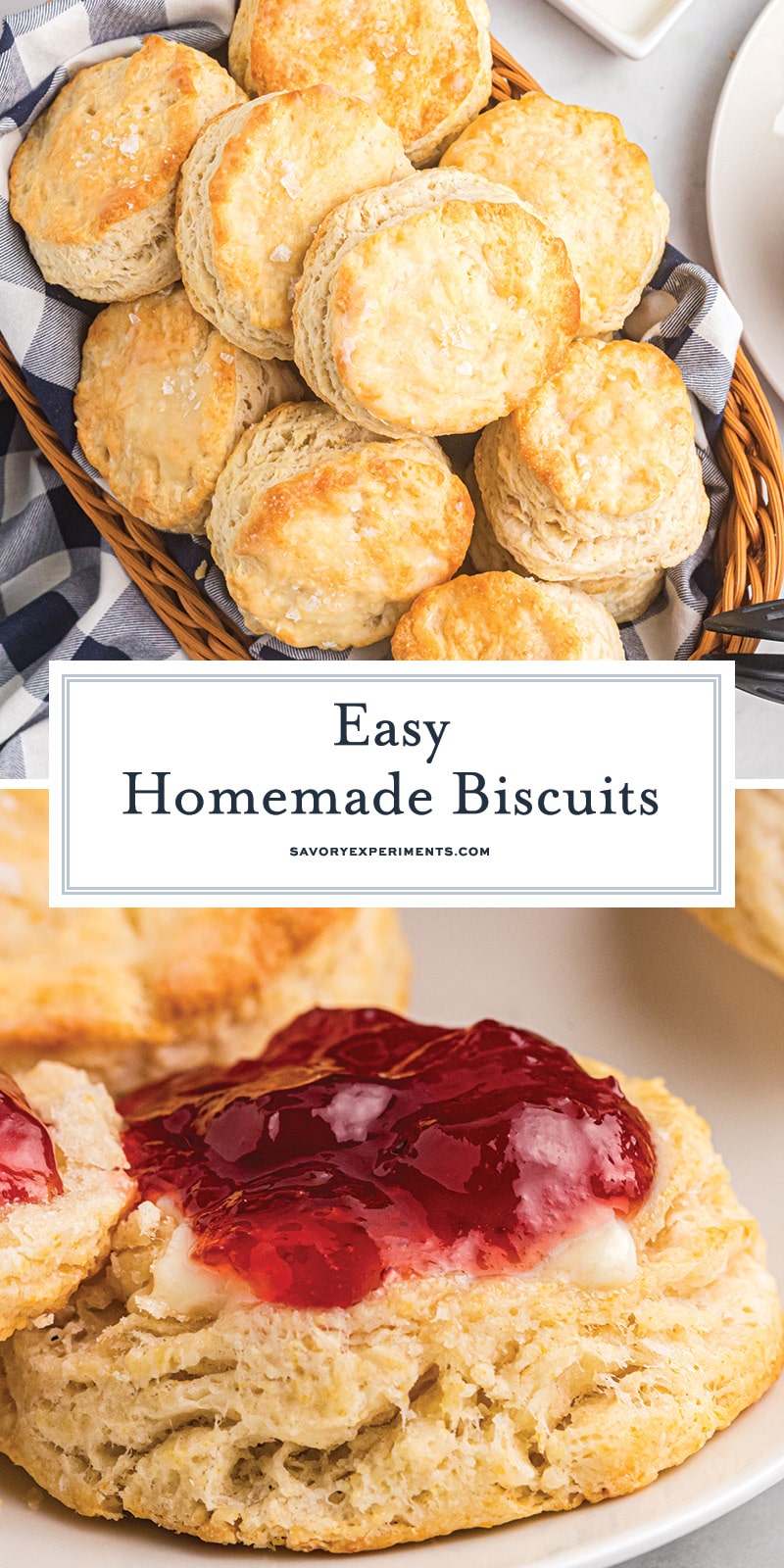

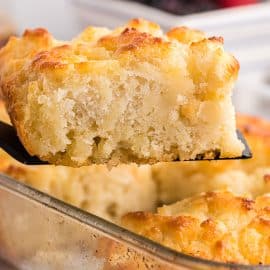
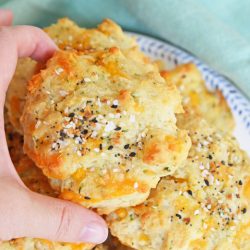

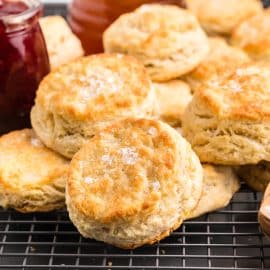

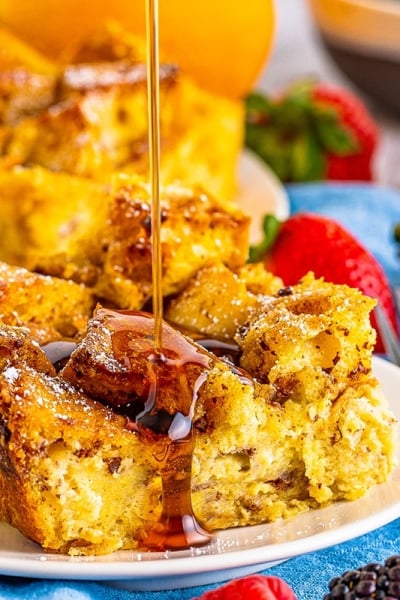
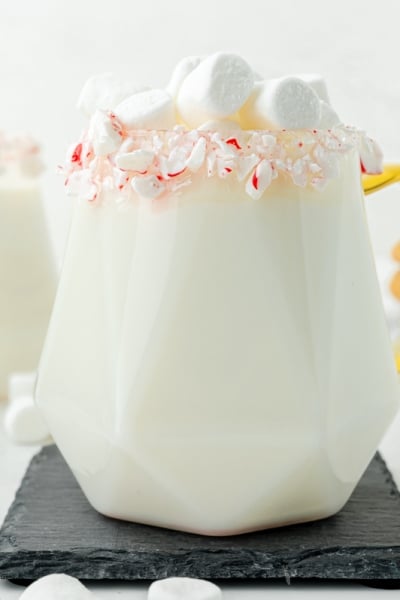
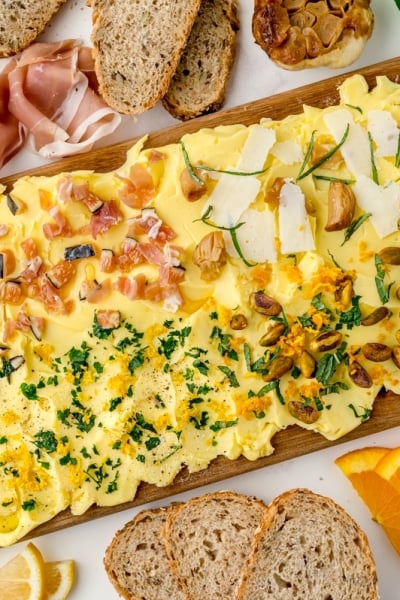
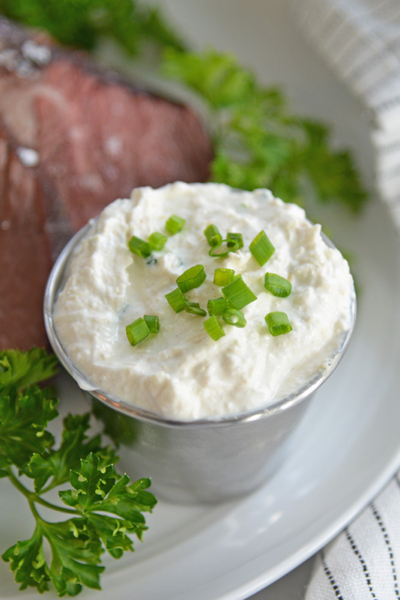
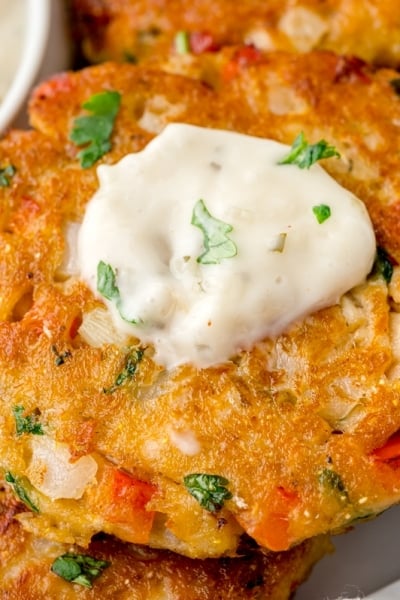
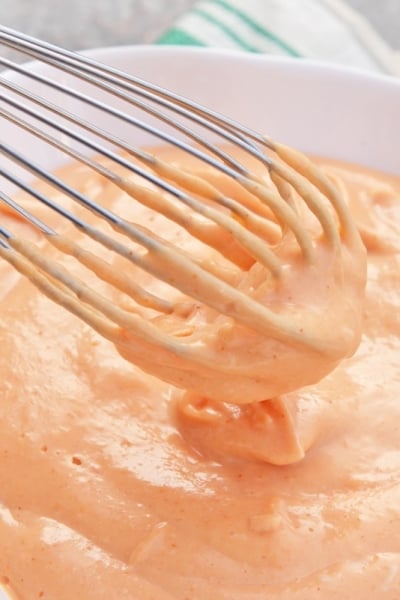
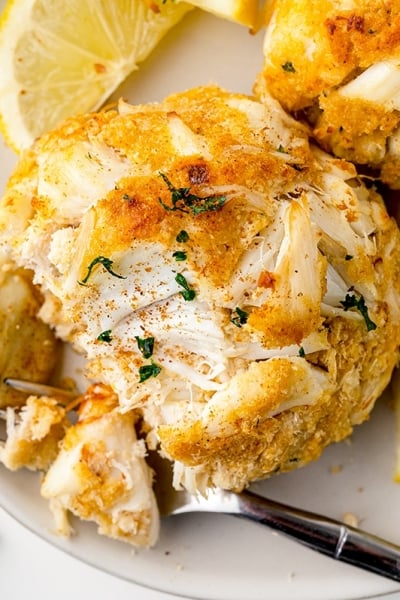
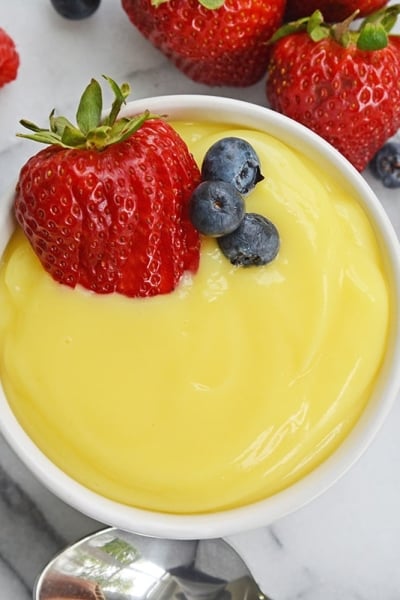
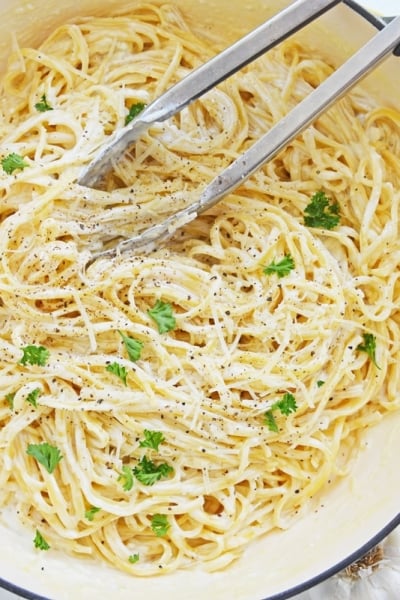
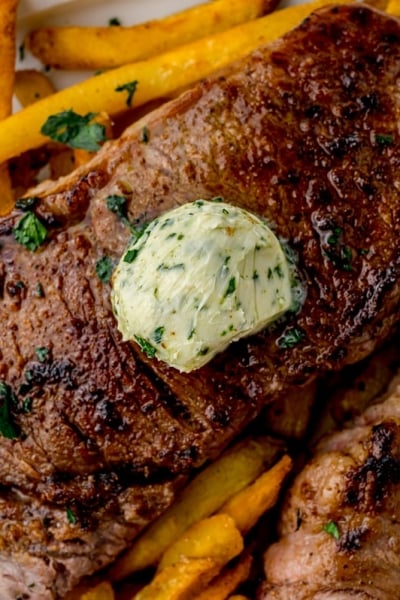







Made these to serve with sausage gravy. 10/10!!
A classic recipe and a tasty one too.
I absolutely love discovering new biscuit recipes and the fact that this one is made without shortening or buttermilk certainly caught my eye! Even without those ingredients you still get the same flaky, tender goodness you come to expect with a delicious biscuit!
These homemade biscuits look so light, fluffy and scrumptious. I’m already thinking about sausage gravy, or a bacon, egg and cheese or maybe just some butter and jelly. Yum!
these are so tall! YUM. great tip to grate the butter